Recently, we ran a poll on LinkedIn asking our audience who they thought was the hardest department to get a reply from.
57% agreed that IT and engineering are the HARDEST industries to get replies from.
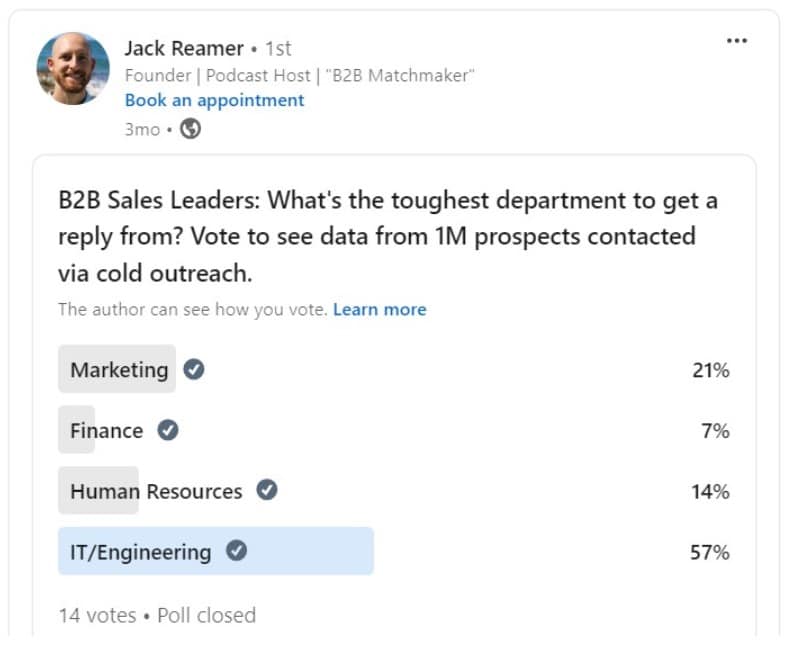
We analyzed data from millions of cold emails sent, and IT was the third-toughest industry to get a reply from, based on our study.
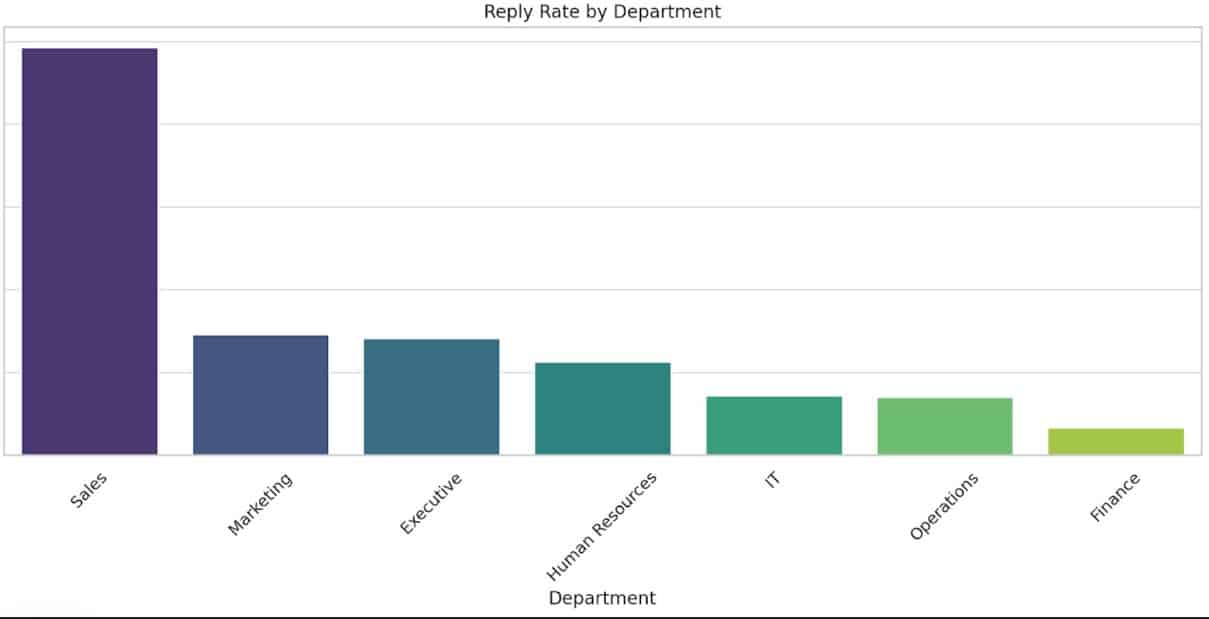
Luckily, LinkedIn receives a 10x higher reply rate than cold email, yet, IT is still a formidable department to get a reply from. (With an average reply rate of 0.72% via cold email.)
You need to take the right approach to get more replies, more high-quality leads, and greater conversions.
This article will highlight some of the best strategies to use for getting high-quality IT prospects.
(If you need a personalized strategy, reach out to us for a free 15-minute strategy session. We love helping B2B companies get 1 high-quality sales lead per day.)
What to consider before your strategy
Before you develop any kind of strategy, you first need to understand what an IT lead is…
If you’re selling IT services, an IT lead could be things like:
-
Custom software development
-
IT Recruiting
Or perhaps you’re selling software to IT professionals, such as:
-
Cyber security
You’re either trying to sell to the IT department or you’re trying to sell an IT service to the executive leaders at the company.
Your strategy will depend on what you’re trying to do.
So, let’s say you’re trying to sell to IT decision-makers or executives on the IT team at the company.
One thing we have learned at Salesbread is that it’s very important to NOT come across as if this IT professional you are reaching out to is doing anything wrong in their role.
We have seen some campaigns where salespeople say: “Do you know your company database is at risk of being hacked?”
Just think about it, if you are the IT director receiving that email:
1. That’s insulting – you’re assuming that they didn’t set up their infrastructure correctly…
2. Do you think that they will pass that email on to any colleagues if it’s calling out that they are doing something wrong?
It’s much more effective to “catch more flies with honey than with vinegar.”
This means that when you reach out to IT departments, it’s important to convey (through your messages) that you are an ally who can assist them with their current mission – NOT compete against them, not call out that they are doing anything incorrectly.
At SalesBread, we try to use phrases like:
-
“How can we help you achieve XYZ faster?”
-
“How can I support your current efforts on XYZ?”
-
“Would love to exchange ideas around this common problem.”
…. As opposed to anything else that could be potentially insulting.
Keep this in mind when deciding on your strategies.
Top lead generation strategies & Tips for more IT and Tech leads
1. Use LinkedIn outreach

At Salesbread, one of our main methods of finding potential customers in the IT space is by using LinkedIn outreach.
At one stage, we were selling enterprise-level cybersecurity infrastructure, and one of our entry points was (because this was frankly, a tougher sell), we would invite the head of IT security onto a podcast.
We framed the question along the lines of talking about today’s current threats and what more IT executives should be aware of…
While the podcast invite was not salesy, it got the conversation started with a lot of these IT buyers. The message established our client as a peer who was actively solving these issues with the heads of IT security together.
So if you’re having a hard time getting reply rates, think about different ways you can start the conversation.
Ask them how they are currently dealing with a particular challenge. This tends to be an interesting conversation starter. If the pain point you are mentioning is acute, it implies that the companies that are dealing with this are on top of their game, considering this challenge.
A lot of our IT outreach is pain-focused, as opposed to mentioning solutions.
It doesn’t work to say: Hey, IT director, you need this product.”
Rather, say: “Talk to me about how you’re approaching this problem. I can share what we’re seeing on our end.”
Use that to start conversations.
Side Note: LinkedIn outreach can bring leads in relatively quickly. At SalesBread, most of our clients see their first positive lead within the first 45 hours after campaign launch. So this might be a good option for your company if you don’t have the time to wait months for leads to be generated (such as with content marketing.)
For more of an in-depth article on how to use LinkedIn for generating leads, read this article: The “1-Lead-Per-Day” LinkedIn Lead Generation Agency
Full case study –
Fintech Lead Generation Strategy – 118 leads in 8 Weeks
Glasswall Case Study – 41% Positive Reply Rate in 40 Days
2. Look for referral partners
Referrals can work for generating IT leads.
Here’s an example:
Think of any app development companies that work with the same kinds of clients, but do not sell the same kind of IT services you do.
You can actually build a list of ideal referral partners and use that as part of your lead generation strategy. You could also ask your current happy clients if they know of any other companies that could benefit from your services.
You might want to include something to sweeten the deal for any referrals sent your way.
Some tips for your referral campaigns:
-
Offer incentives to your clients for successful referrals; This could be a commission or gift card. Anything that will make people want to refer others to you.
-
You can also promote your referral program through newsletters and social media
-
Make sure that if you do choose to use a referral campaign, it’s easy for clients to follow through. For example, don’t have a huge list of questions that they need to answer.
-
Ensure that you have a system that tracks referrals, and be sure to follow through quickly on any incentives you’ve offered.
-
Keep tabs on your referral programs to make sure that they are worth your while, and pivot if you notice any improvements that need to be made.

Here’s an example of Evernote’s referral program that has since stopped, but it’s still a pretty good example.
Their customers could earn 10 points for their first three referrals –
That was enough for three months of Premium or 3 GB of additional monthly upload, then whenever a referred friend bought Premium, they would then earn 5 points.
The results were as follows: Out of the 225 million users, 13% were referred by other users.
Their simply designed program encouraged customers to keep making referrals to sustain their free trial of Premium.
3. Make use of content marketing
According to a study done by Forbes, 74% of companies said that content marketing has increased their lead generation.
If you look at the graph below, you will notice that most businesses spend their money on social media and community-building forms of marketing.
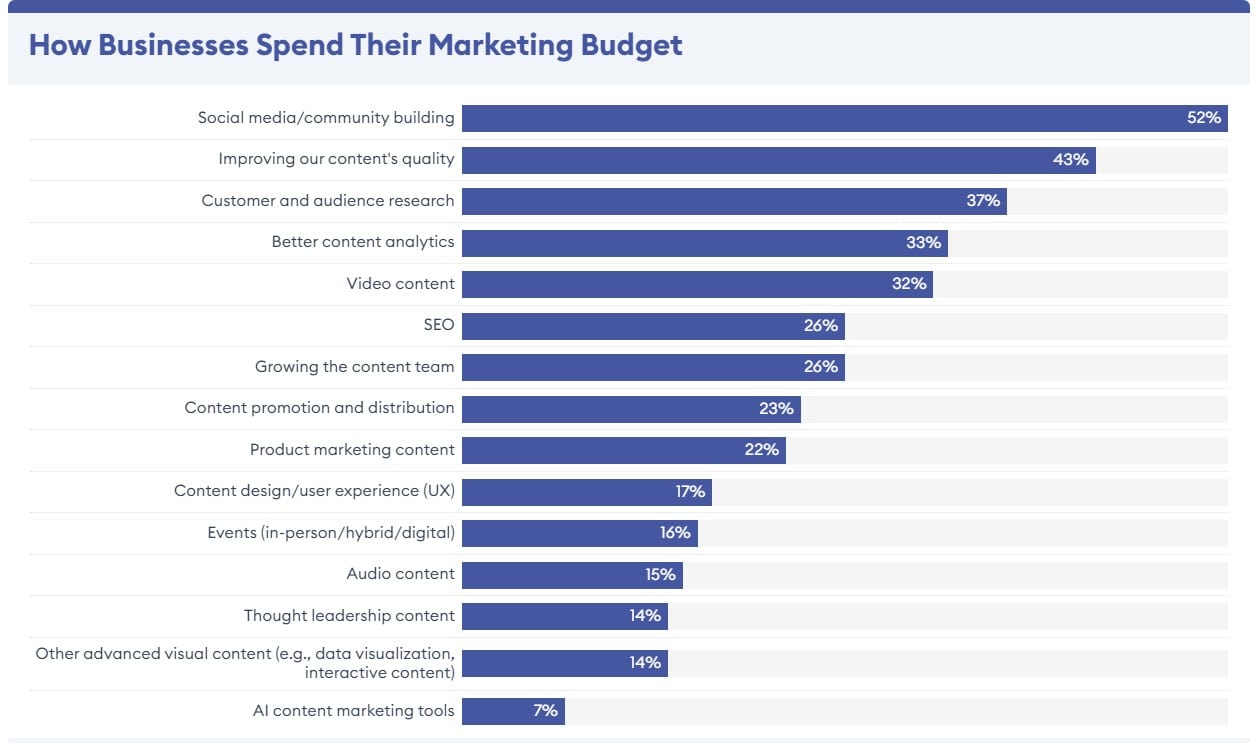
At SalesBread, we mainly focus on outbound lead generation, but content marketing has proven very successful for generating IT leads.
If you are using social media, focus on thought leadership style content.
If you can educate your market on their options for solving their particular challenges, this could really resonate with them, and they might just reach out to you for help.
Some examples we have seen are companies that produce a white paper and then use LinkedIn or Google Ads to promote that very specific white paper to get into the hands of their end buyers. This really helpful content normally packs a punch.
And as a bonus, if you are writing a white paper around the challenge as opposed to the solution, typically that cost per click is going to be a lot lower.
Share your insights with your audience on LinkedIn, Twitter, and even YouTube.
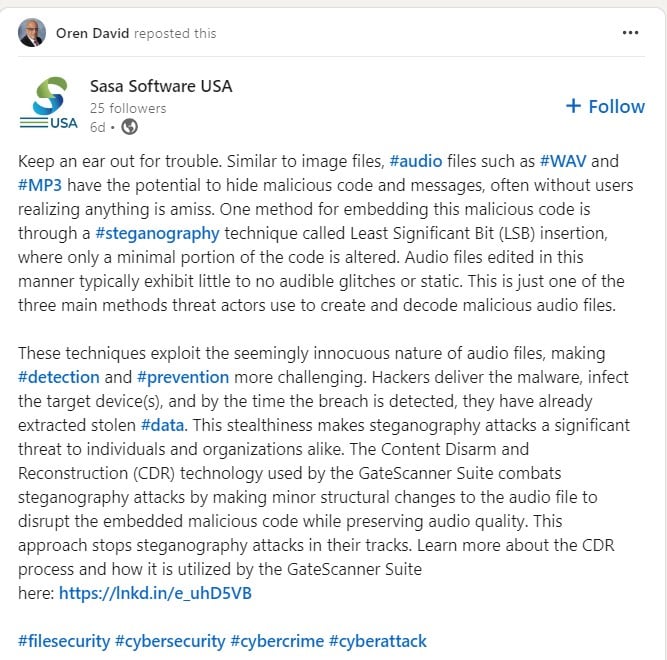
Above is an example of how you could use social media to share helpful information with your audiences.
You could share stats, interesting information, polls, and even case studies with your audience to show that you are a leader in your industry.
Another option is to use an SEO strategy and blogs.
With SEO you could either hire an agency or a freelancer who has a good track record of getting conversions through SEO.
SEO takes time, so be prepared to wait a little while for leads to come in. This is especially true if your site is brand new. On average, it can take between 3 and 6 months for SEO lead generation to take off.
If you are interested in learning more about SEO, take a look at Grow & Convert’s website. They have a ton of helpful resources for companies on how to run successful SEO campaigns.
4. Attend IT & technology events
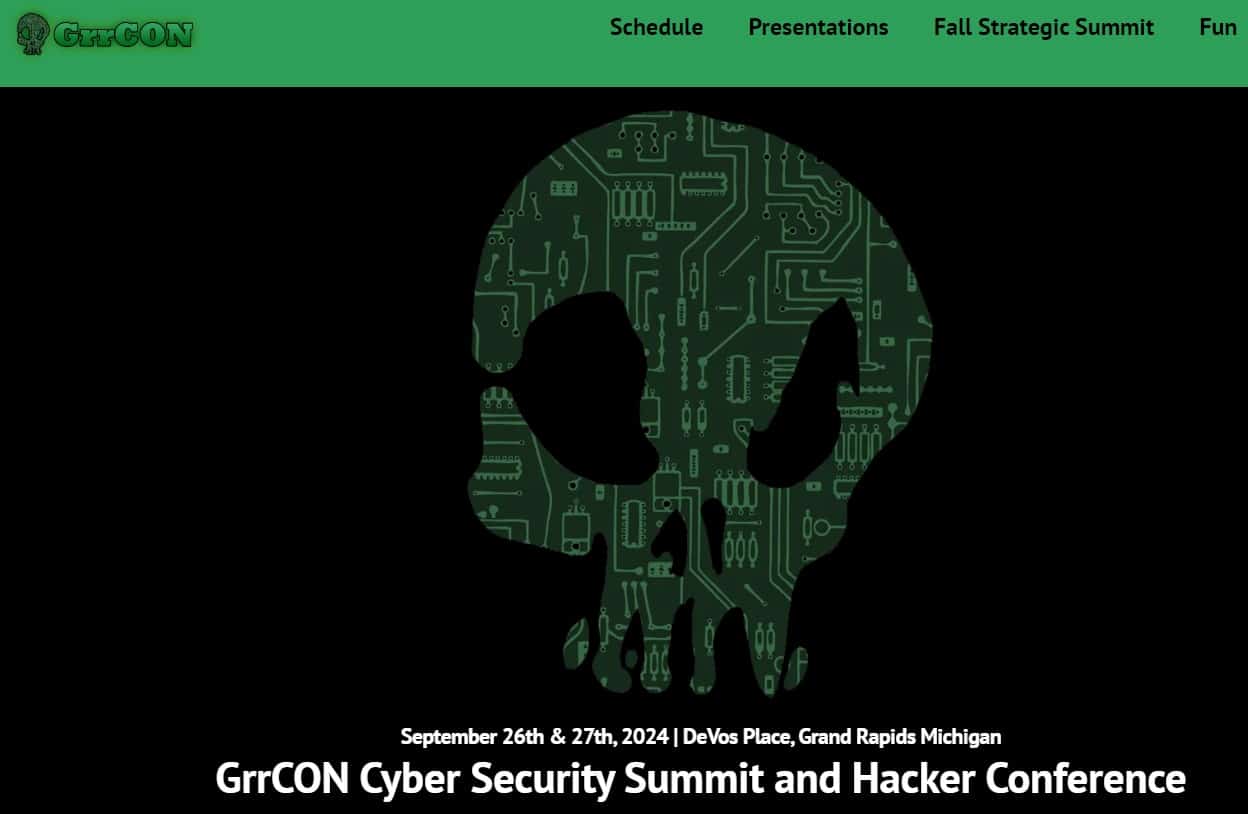
Attending IT conferences and events will help you network with companies and like-minded individuals. You could share your insights, set up your booth, depending on the type of event, and learn from industry leaders.
You want to try to engage with participants, exchange business cards, and even look for potential partnerships.
Likewise, you could also participate in discussions or see if you could become a keynote speaker. This is a great opportunity to show off your expertise.
It’s also important to follow up with leads after the conference.
5. Do not use cold calling to generate IT leads
Don’t try cold calling to generate IT leads.
It’s just not going to work.
Test it out.
Pay for the phone numbers of 100 IT directors, try to call them, and see how that goes.
The chances are they either won’t answer your call or won’t be impressed. Cold calling works in industries where people use their phones a lot. Think about those in construction.
They often call one another to quickly put out work fires. It’s an industry where the phone gets used a lot. In the IT world, that’s not it.
They use tools like Slack or email and are frankly allergic to cold calls.
It’s really an uphill battle, and if you’re still curious, it doesn’t cost a lot to buy 100 phone numbers and try. But I think you’ll find that that’s an industry that just doesn’t respond to cold calling.
6. Reach out to the correct people at your target accounts
If you choose to do outreach, whether it’s via cold email or LinkedIn, ensure that you reach out to the right decision-makers at these companies.
To answer this question, you need to look at the size of the companies you’re going after.
We can pretty much all agree that the most senior IT decision-maker at any firm would be the CTO (chief technology officer.) But for mid-level companies, you might want to reach out to those with the titles:
-
Head of IT
-
Head of technology
-
VP of technology
-
Technology and innovation roles
And larger firms will have a Chief Information Officer, a CIO.
The idea is that it differs from account to account. As opposed to worrying about every org map, have a list of your ideal titles.
If CIO is your dream decision maker, great, add that, but you will need several fallbacks because a lot of accounts won’t have a CIO. Then you need to say: “If no CIO, we will go after CTOs,” and “If no CTO, we will go after the head or VP of technology.”
You can use this logic to find the decision maker at each company, as opposed to missing out because you did not allow some flexibility per account in your targeting.
7. Reach out to ideal prospects in your city
If you are selling an expensive service or product to IT, it may be beneficial to start with a campaign of prospects that are located in your city.
The reason is that playing the local card works.
It’s an easy way to draw similarities between you and your prospects. You just stand a better chance of getting better reply rates when you reach out to folks in your city.
When we do this, we will invite them to have the option of either a quick Zoom chat or an in-person coffee meeting.
A lot of people prefer Zoom chats still.
This is a perfect example of sales psychology.
Robert Cialdini, an American psychologist, wrote a book called influence. In it, he mentions the “liking principle” and how we trust people who are similar to us.
You can learn more about this in the video below:
7. Share more case studies and testimonials

Try to share testimonials and case studies on your website.
You could even create an account on a platform like G2, where customers can give you reviews.
This creates trust and social proof.
If potential new customers see how you helped other companies solve their problems, and you explain in detail how you achieved this, the chances of them trusting you to fix their issues will be greater.
Ask your current clients if they could leave you a brief testimonial, whether it’s for your site or for social.
According to Optin Monster, social proof increases conversions by 15%.
Here are some more stats that show how important social proof is:
(Note: This information comes from Optin Monster. )
- 87% of buying decisions begin with research conducted online before the purchase is made.
- The average consumer reads 10 online reviews before making a purchase decision.
- 88% of consumers trust user reviews as much as personal recommendations.
- 82% of Americans say they seek recommendations from friends and family before making a purchase.
- 64% of consumers need to hear company claims 3-5x before they actually believe them.
8. Host webinars
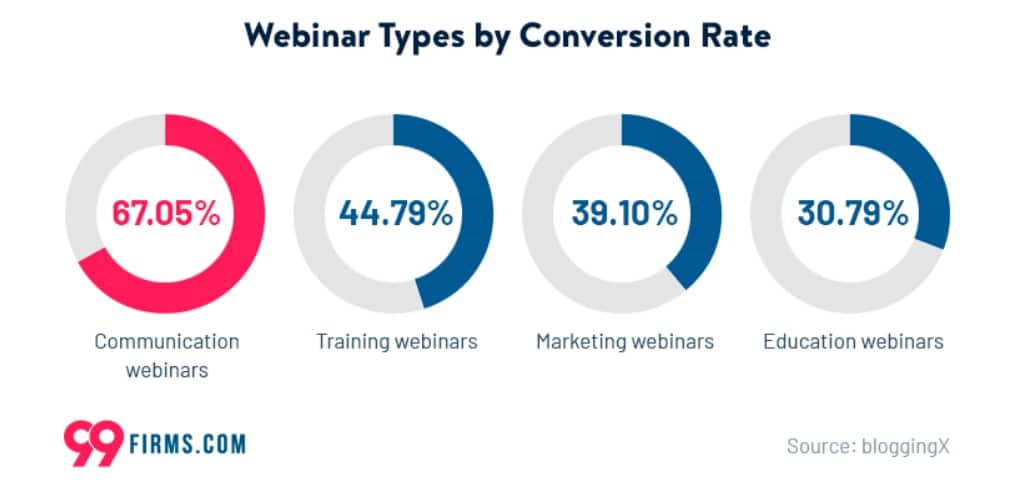
Webinars are a great way for companies to generate IT leads because you can showcase your expertise while directly engaging with potential customers.
Businesses can attract an audience who’s seeking solutions by hosting a webinar on relevant IT topics—such as cybersecurity trends, cloud solutions, or software innovations.
These attendees often convert into leads, especially when companies provide value through your expert insights or interactive Q&A sessions.
Plus, webinars allow for follow-up opportunities, like sharing the recorded session or offering additional resources.
9. Hire lead generation companies to find new customers
Generating high-quality sales leads in the IT space can be challenging, especially if you don’t have the time or experience to do this yourself.
This is where a lead generation agency can help.
There is a caveat, though: It’s important to hire an agency that has experience in your space. So, ask for examples of where they have helped companies like yours generate IT leads. Find out what the results were and what their method was.
For example, at SalesBread, we have helped many companies successfully find IT leads through LinkedIn and cold email outreach.
We are happy to share case studies, strategies, and testimonials. Our clients know that when they partner up with SalesBread, they will get 1 qualified sales lead per day.
Even at the end of our partnership with our clients, we actually teach them how to run their own lead generation campaigns, so that they can bring the whole process in house.
If you’re interested in learning more about our methods, read this article: The “1-Lead-Per-Day” LinkedIn Lead Generation Agency.
10. Use Surveys

(Image Source: Survey Monkey.)
Surveys are a great tool for IT companies to generate leads.
When designed strategically, they can easily engage potential customers, provide valuable insights, like what their pain points are and their budget. Besides this you can also use it to capture contact information.
The key is to create surveys that offer value to participants while also helping businesses identify and connect with prospective leads.
Many businesses, especially B2B lead generation companies, use surveys as part of their lead generation efforts to build a strong sales pipeline and improve their sales process.
The first step in using surveys for B2B lead generation is defining a clear purpose.
A good survey should focus on a relevant industry topic, pain points, or trends.
For example, tech companies specializing in cybersecurity might ask, “What are your biggest IT security concerns for 2025?”
This not only sparks interest but also helps the company understand the pain points of its target customers, leading to more qualified leads.
Once the purpose is clear, it’s important to target the right audience.
Technology companies can share their surveys through platforms like LinkedIn, through email marketing campaigns, paid ads, and industry forums.
Social media platforms also play a role in reaching prospective customers, making social media marketing an essential part of lead generation solutions.
Offering incentives can also boost survey participation.
People are more likely to respond if they receive something valuable in return.
Software companies can offer a free industry report, a white paper with exclusive insights, discounts on services, or even an entry into a giveaway.
These incentives make the survey feel like a mutually beneficial exchange rather than just a data collection effort.
This approach also enhances inbound marketing and strengthens a company’s core business by nurturing relationships with potential clients.
Keeping the survey short and engaging is another crucial factor.
Long surveys might put people off, so it’s best to limit the questions to around 5-10. A mix of multiple-choice and short-answer questions keeps respondents engaged while still providing useful information.
The goal is to make it easy for participants to complete the survey without feeling overwhelmed.
It’s also really important to capture contact information of your B2B leads.
Companies should include an optional field for participants to leave their email addresses if they want to receive the survey results or exclusive insights.
However, it’s important to ensure compliance with data protection laws like GDPR or CCPA, assuring participants that their information will be handled responsibly.
Surveys can also serve as a lead qualification tool.
By asking targeted questions, IT companies can segment respondents based on their needs and interests. For example, a question like
“What IT solutions are you currently considering?” can help identify potential buyers who are actively looking for services.
This allows businesses to prioritize high-quality leads and tailor their follow-up strategies accordingly. B2B marketing strategies often rely on market research and lead research to better understand competitors and refine sales and marketing strategies.
Once responses are collected, following up with personalized outreach is key.
IT companies can share customized survey results or insights with participants, offering solutions that address their specific needs. Whether through email follow-ups or sales calls, personalized engagement increases the chances of converting survey participants into loyal customers.
A strong sales team that also uses lead generation software, such as Salespanel or LeadGenius, can streamline the process of turning a list of leads into actual revenue, by keeping tabs on your leads.
Finally, survey data can be repurposed for digital marketing and content marketing efforts. IT companies can use the collected insights to create reports, blog posts, infographics, or webinars, attracting even more prospective leads.
For example, a company could publish “The State of IT Security: 2025 Trends from 500+ Companies,” showcasing the survey findings in an informative way.
This not only builds authority but also generates additional interest in their services. Gen campaigns and leadgen services further enhance the effectiveness of these efforts, keeping other businesses engaged and informed.
Survey example
Tech & IT Lead Generation Survey
Introduction: We’re constantly working to improve our services and better understand the needs of our clients. Your feedback will help us provide tailored solutions to meet your needs. This survey should take only 5–10 minutes, and as a thank you, you’ll receive [insert incentive, e.g., a free industry report].
1. What is your role within your company?
-
CEO/Founder
-
IT Manager
-
CTO/Technology Director
-
Developer/Engineer
-
Other (please specify)
2. What size is your company?
-
Small (1-50 employees)
-
Medium (51-200 employees)
-
Large (201+ employees)
3. What are the biggest IT challenges your business is currently facing? (Select all that apply)
-
Cybersecurity concerns
-
Cloud migration and management
-
IT infrastructure scaling
-
Software development needs
-
Data management and analytics
-
Compliance and regulations
-
Other (please specify)
4. What IT solutions are you currently considering or exploring? (Select all that apply)
-
Cybersecurity solutions
-
Cloud services (e.g., AWS, Azure, Google Cloud)
-
Enterprise Resource Planning (ERP) systems
-
Custom software development
-
IT infrastructure management
-
Data analytics and business intelligence tools
-
Other (please specify)
5. How do you currently handle your IT services and solutions?
-
In-house team
-
Outsourced to an IT company
-
Combination of both
-
We are exploring outsourcing options
-
Not applicable (we don’t have IT services)
6. What is your biggest priority for the next 12 months regarding IT?
-
Improving cybersecurity measures
-
Upgrading IT infrastructure
-
Migrating to the cloud
-
Implementing new software tools
-
Managing data and analytics better
-
Improving IT team performance
-
Other (please specify)
7. What is your budget range for IT services or solutions in the next year?
-
Less than $10,000
-
$10,000 – $50,000
-
$50,000 – $100,000
-
Over $100,000
-
Not sure yet
8. Are you currently using any lead generation software?
-
Yes, we use tools like Salespanel, LeadGenius, etc.
-
No, we are not using lead generation software at this time
-
We are looking for lead generation solutions
9. Which of the following best describes your interest in exploring new IT services?
-
We are actively looking for solutions and vendors
-
We are in the research phase, but not yet ready to buy
-
We are exploring options for the future
-
We are not interested at this time
10. Would you like to receive a free consultation or a demo of our services?
-
Yes, I’m interested in a consultation/demo
-
No, thank you
11. Please provide your contact information to receive the survey results or further insights:
-
Name:
-
Email:
-
Company Name:
-
Phone Number (Optional):
Thank you for completing our survey!
Your responses will help us provide you with more relevant information and tailored solutions. We will follow up shortly with the results or a consultation offer.
Quick recap:
If you’re looking for more leads in the IT space, do the following:
-
Use LinkedIn outreach
-
Look for referral partners
-
Use content marketing
-
Attend IT conferences and events
-
Don’t cold call IT directors
-
Reach out to leads in your city
-
Share more case studies and testimonials
-
Host a webinar
-
Hire lead generation services
-
Use surveys
Interested in a free strategy session?
Hop on a free 15-minute strategy session with Jack Reamer, the founder of Salesbread. We will be happy to help you figure out a way to reach out to some of the most challenging prospects in the industry.
